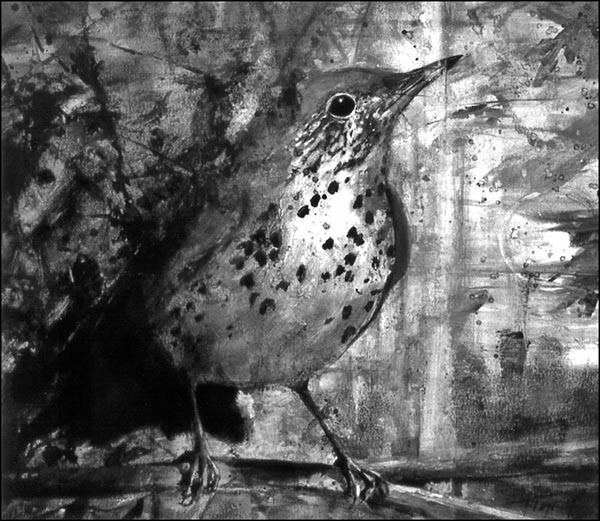
When we moved to Thetford, Vt., in 1985, I marveled at the variety of forest songbirds in our midst. I counted as many as 26 species a year just in our backyard. Of all these, the most thrilling was the wood thrush. Its glorious song, a wild and ethereal ‘e-olay,’ would send primal shivers up my spine. Spring did not arrive until we heard the first wood thrush. However, as the years passed, we heard its song less often, and now not at all. What is happening?
Wood thrushes are neo-tropical migrant birds. They are among many species that divide their lives between two worlds: the forest of the northeastern United States, where they raise their young, and the forests of Central America, where they winter. More than 70 species of our summer songbirds are neo-tropical, including the scarlet tanager, Baltimore oriole, chestnut-sided warbler and indigo bunting. When it’s snowing in New
Hampshire and Vermont, they are wintering in such
countries as Honduras, Nicaragua and El Salvador.
Most of these birds need large forest areas in both the United States and Central America to survive. The wood thrush, with large eyes that help it see well in deep shade, forages in leaf litter on forest floors. But the thrush faces a problem: The extensive rainforests that once clothed Central America are fast disappearing. Over the past four decades an estimated 80 percent of the rainforests have been cleared for agriculture or other uses. Over that period, ornithologists have noted a 40 per cent decline in neo-tropical migrant bird populations.
Enter coffee, North America’s favorite wake-up drink. Historically the coffee beans that we consumed came largely from Coffea arabica, a forest understory bush that grew in the shade of trees on the plantations of Central America. Researchers have shown that with the disappearance of the rainforest, these wooded plantations provided a livable forest substitute for many migrant songbirds, including the wood thrush.
Unfortunately, the economics of coffee production and marketing began changing several decades ago. As demand for coffee increased, growers began looking for greater efficiency in raising beans. They switched to Coffea robusta bushes that, with applications of chemical fertilizers and pesticides, can be grown as monocultures in full sunshine. While they are more productive, these coffee plantations without trees offer nothing in the way of bird habitat.
Today, the World Resources Institute reports that about 40 percent of coffee growers in Central America have converted to intensive, ‘sun-grown’ Coffea robusta production. (From a flavor standpoint, these beans are considered bitter and inferior to Arabica beans, but bitterness can be masked through processing.) The loss of so many shade coffee plantations is a blow to the winter survival of migrant songbirds.
Rather confusingly to the consumer, some growers utilize an intermediate form of cultivation—known as ‘partial shade’ – so they can claim that their coffee is shade-grown and thus superior. However, many noted ornithologists, among them Bridget Stutchbury, a professor at York University in Toronto and author of “Silence of the Songbirds,” have found in their research that partial-shade plantations are inadequate as bird habitat.
Ironically, ‘sun-coffee’ monoculture has begun posing problems for growers as well as birds. During market gluts, coffee growers find themselves with fewer agricultural or forestry options to fall back upon. Traditional shade plantations, comprising scores of different species of trees, had provided other important products, such as firewood, timber and fruits such as citrus, mangos and avocados; and in their shadows grew various plants that produced medicinal drugs. Without alternate crops to fall back on, many ‘sun coffee’ growers went bankrupt when the market value of coffee plummeted.
Amidst this gloomy scenario have emerged several glimmers of hope. Consumers in America in recent years have been given the option of buying organic coffee (good for the environment and human and bird health) and “fair trade” coffee (good for poor Central American farmers, who get better pay.) But there’s another designation that directly aims at helping birds. It’s the Smithsonian Institute’s “Bird Friendly” stamp of approval, which identifies true shade-grown coffee. The designation by the Smithsonian’s Migratory Bird Center also assures that the coffee is organic and “fairly traded.”
Currently 2,400 producers farming about 20,000 acres bring over 8 million pounds of “Bird Friendly” coffee to the global marketplace. Compared to the 3 billion pounds of coffee imported by the United States each year, this number is miniscule. However the market for sustainably grown coffee is growing.
That’s good news for serious coffee drinkers in our region. Imagine awakening with a steaming cup of fine arabica coffee and the lovely song of the wood thrush just back from winter vacation.


Discussion *